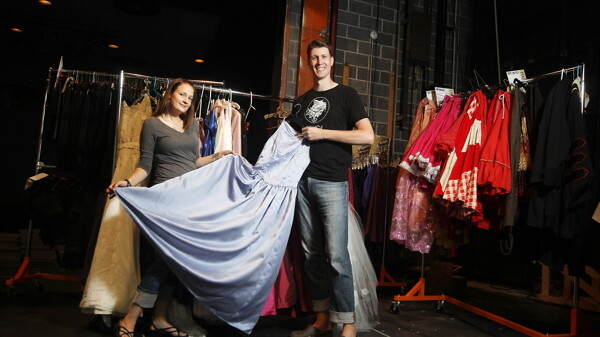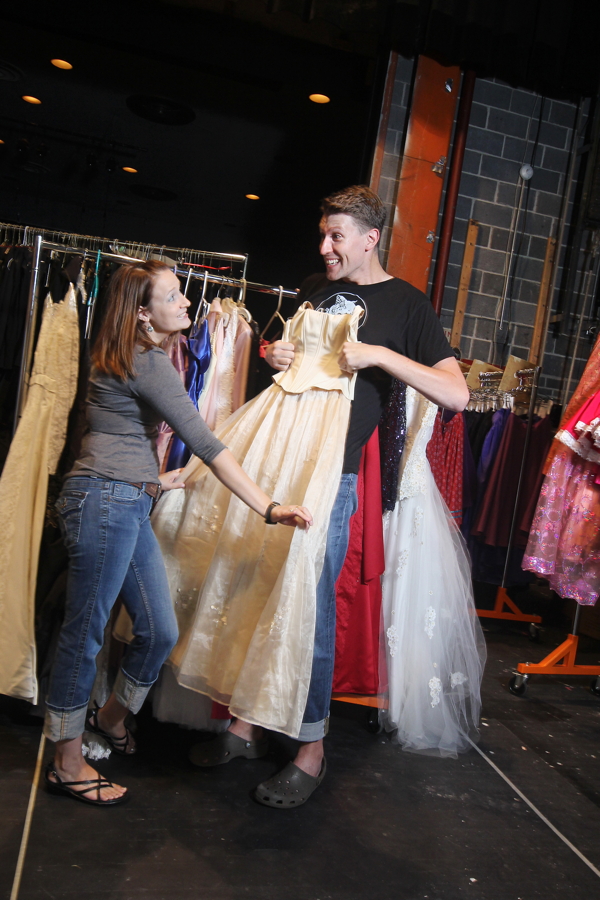Dresses to Impress
program converts prom garb into period costumery
Kinzy Janssen, photos by Andrea Paulseth |

If there’s one thing theatre programs are used to, it’s a shoestring budget. But when Amanda Profaizer first heard the proposed costuming budget of $2,000 for UW-Eau Claire’s biannual opera, she gasped.
“How do you do a period opera [Die Fledermaus] with upper class characters going to a ball... on that? We needed it to be true to the piece,” says Profaizer, professor in the Music and Theatre Arts department at UWEC.
After perusing old catalogs and fashion magazines, she came across a prom dress combining a satin skirt with a corset top. Already envisioning the lavish layers she could pile on top of that structure, she suddenly knew how to solve the budget crisis – by salvaging used formal dresses from thrift stores and building them into Victorian ball gowns.

ME LOOK VICTORIAN?
“I mean, if you look at these gowns,” she says, showing me drawings from a historical fashion book, “there are flowers, buttons, trim, lace, a bustle... just so much... stuff. So it’s not a simple silhouette. And I knew I couldn’t do it by myself.”
That’s when Jake Lindgren, a nontraditional undergraduate student in the Fine Arts program, entered the picture. The pair applied for an Office of Research and Sponsored Program (ORSP) summer grant that exists to develop student-professor mentorships. They were each awarded a $2,300 work stipend to cushion the workload, while planning to reserve the initial school-issued budget for services like dry cleaning and supplies like thread. Lindgren stresses that while the economy slogs along, people continue to expect great things – which only serves to motivate him more.
“I wanted it all to be done by donation,” says Lindgren. “These women paid so much for these dresses initially that they don’t want to just drop them off at Saver’s.” He speaks of the connection that is forged between a woman and a gown, and his mission is to pay tribute to that by coaxing old dresses out of storage and giving them a long-awaited spotlight. “This whole project is about ‘an old dress; a new story.’ I take that seriously and I want to uphold that by putting forth a final product that they can be proud of,” he says, noting that 30 gowns are already weighing down his closet rack at home after a word-of-mouth campaign.
To follow the metamorphosis of the dresses, snip by snip, button by button, Lindgren proposed a photo blog. Christina Rambo, local artist, photographer, and blogger, has volunteered to set it up and maintain it.
Profaizer and Lindgren have already surrendered their Christmas breaks to the sweat equity required to produce 30 to 40 ball gowns. Even those numbers are deceptive – a single Victorian ball gown may need to harvest materials from up to ten plainer dresses. Lindgren speculates with a laugh that they’ll need 200 dresses – a joke that is fast approaching reality. They’ll have some help though, through a costuming class Profaizer will teach this fall involving about 15 students.
When it comes to getting help from the cast, however, Profaizer believes in minimizing it.
“I like to be able to tell the characters, ‘you just learn the music.’ You don’t have to worry about bringing your own hat, or anything… Russell Crowe did not provide his own gladiator costume for the movie,” she adds, quashing an apparently common misconception.
Profaizer and Lindgren agree that costuming is not an afterthought; it is an integral part of the play’s impact – especially on the people embodying the characters.
“For me, my character was never complete until I had my costume,” says Lindgren. “It gave me stage business, it gave me mannerisms… it was a crucial step. So it was an easy transition to get into telling a story through clothes.”
For this unprecedented project, Lindgren hopes to garner support from all corners of the community.
“The problem is that this town is loyal to one theater program. Each organization has a different audience and there isn’t much crossover. I want it to be more of a community event. That’s my goal for this,” he says. Just one goal of many.
For information on donation and to follow the progress of the project, visit www.PromQueenVictoria.blogspot.com.






















